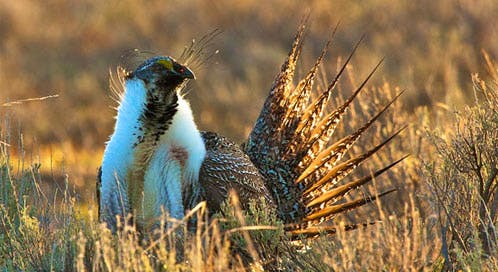The tiny town of Winifred is in east-central Montana, an hour north of Lewistown and south of the rugged and beautiful Missouri Breaks National Monument. It is, as some people might describe it, in the middle of nowhere. It’s also in the middle of sage-grouse country, adjacent to one of the largest remaining populations in the state. And that’s why two Defenders of Wildlife staff and one dedicated volunteer recently took a wintry trip there to conduct sage-grouse conservation field work.
Winifred is a ranching community where ranchers have raised cattle for generations, mostly on private land. Tens of thousands of miles of livestock fences stretch across the West in communities like Winifred, presenting a dangerous barrier to wildlife on the move. One way to lessen the impacts of livestock fences is by marking, or flagging, those that are “high risk.” Barbed wire fences in particular can be harmful or lethal to many species of wildlife attempting to cross over or under them, including sage-grouse.
Sage-grouse, once a common sight in the West, are now imperiled, with current populations estimated at less than ten percent of historic levels. The birds are low, powerful fliers, known to fly before sunrise to their breeding grounds. When flushed, they sometimes fly directly into barbed wire strands…with gruesome results. Fences near sage-grouse breeding and nesting habitat and wintering areas can be especially hazardous.
An obvious step to reduce this threat is to remove fences, and we’re eager to find ways to help land management agencies and private landowners to do so. However, where fence removal is not an option, research has also found that the dangers posed by fences can be mitigated by clipping markers onto the fence to help sage-grouse see the skinny wires before they strike them. A study of sage-grouse and fence collisions by the Wyoming Game and Fish Department suggested that markers reduced sage-grouse mortality in the study area by 61 percent between 2007 and 2009. A second field experiment conducted in Idaho in 2010 found an approximate 83 percent reduction in collision rates at marked fences relative to unmarked fences.
Defenders partnered with the Natural Resources Conservation Service (NRCS), and a willing and helpful rancher who was pleased to have our assistance in marking his fences for sage-grouse. Along with NRCS’s sage-grouse expert Bruce Waage and local NRCS district conservationist Lorna Philp, Defenders staff Mark Salvo and Kylie Paul, and intrepid volunteer Ben Donatelle, walked numerous miles of snow-drifted fences along the rancher’s property, which is located near a sage-grouse lek (a crucial breeding ground that the birds return to year after year). Flagging fences was not difficult; we clipped tags cut from vinyl house siding (provided by NRCS) every three to four feet onto the top wire of the fence. And, while we were at it, we thoroughly enjoyed the brisk temperatures, amazing sunsets, and serenading coyotes that are a part of everyday life of this unique landscape.
Our recent trip to the field was edifying. We learned that flagging fences with markers is a relatively quick and easy job that can potentially save sage-grouse from injuries or death – so we plan to partner with NRCS and private landowners in Montana, and perhaps elsewhere, to hang more of these fence markers in sage-grouse habitat.
[portfolio_slideshow id=25433]
Kylie Paul is Defenders’ Rockies & Plains Representative. Mark Salvo, Director of Federal Lands Conservation contributed to this post.



